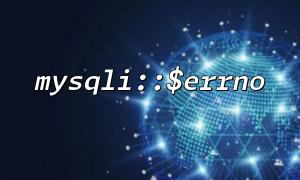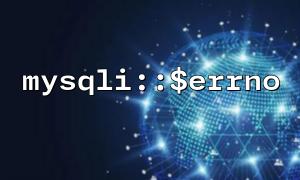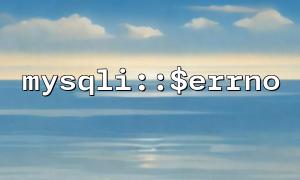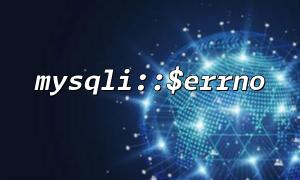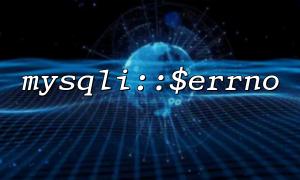In PHP programming, using the mysqli_connect() function to connect to a MySQL database is a very common operation. However, error handling is an essential part of real-world development. Especially when the database connection fails, we often need to check the database connection error code to quickly locate the problem. So, why is it necessary to check mysqli::$errno after using mysqli_connect()? What can this error code tell us?
mysqli_connect() is a PHP function used to establish a connection with a MySQL database. With this function, we can perform queries, inserts, updates, and other operations on a MySQL database. The basic syntax of mysqli_connect() is as follows:
$connection = mysqli_connect($host, $username, $password, $database);
If the connection is successful, the $connection variable will contain a database connection resource. If the connection fails, it returns false, and you should immediately handle the error.
mysqli::$errno is a property representing the error code of the last MySQL operation. Regarding mysqli_connect(), this error code helps developers understand why the connection failed. The value of mysqli::$errno is an integer representing the error number returned by the MySQL database.
When a database connection fails, we can check the false returned by mysqli_connect() and further inspect mysqli::$errno and mysqli::$error to learn more about the cause. mysqli::$errno stores a numeric error code, while mysqli::$error holds a detailed error description.
Checking mysqli::$errno is crucial for handling database connection errors. By inspecting this error code, developers can:
In many cases, database connection failures can stem from various causes. Common errors might include:
Incorrect hostname ($host) or IP address
Incorrect database username or password
Database service not started or unreachable
By checking mysqli::$errno, we get a numeric error code that helps quickly determine the root cause.
mysqli::$error, as a string, offers more detailed error messages. Without checking mysqli::$errno, developers might miss the specific reason for the connection failure. Viewing mysqli::$error gives a textual explanation of the failed connection.
For example, when a connection fails, you can use the following code to check and print the error:
$connection = mysqli_connect($host, $username, $password, $database);
if (mysqli_connect_errno()) {
echo "Connection failed: " . mysqli_connect_error();
}
This way, you can immediately see detailed error information when the connection fails.
Some errors require different solutions depending on the scenario. For instance, if mysqli::$errno returns "1045," it means the password is incorrect; if it returns "2002," it means the database host cannot be reached. Developers can address problems more effectively by targeting specific error codes.
Here are some common mysqli::$errno error codes and their meanings:
1045: Access denied for user (incorrect username or password)
2002: Can’t connect to local MySQL server (cannot connect to MySQL server, possibly wrong database server address)
2003: Can’t connect to MySQL server on 'hostname' (wrong hostname or database service not started)
1049: Unknown database (specified database does not exist)
These error codes help developers pinpoint problems more accurately, avoiding unnecessary debugging efforts.
Below is a complete example showing how to check mysqli::$errno to handle database connection errors:
<?php
$host = 'm66.net';
$username = 'root';
$password = 'password';
$database = 'example_db';
<p>$connection = mysqli_connect($host, $username, $password, $database);</p>
<p>if (mysqli_connect_errno()) {<br>
echo "Connection failed, error code: " . mysqli_connect_errno() . ", error message: " . mysqli_connect_error();<br>
} else {<br>
echo "Successfully connected to the database!";<br>
}<br>
?><br>
In this example, we first try to connect to the database. If the connection fails, we use mysqli_connect_errno() to get the error code and display it. If the connection succeeds, a success message is shown.
When using the mysqli_connect() function for database connection, checking mysqli::$errno is very important. This error code helps us identify the specific reasons for database connection failures, provides detailed error information, and allows us to take appropriate actions based on different error codes to solve the issues. Therefore, developers must pay close attention to error handling during database connections to avoid overlooking potential connection problems.

